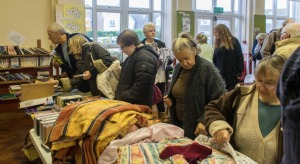Rye’s Community Garden (shown above) is in Love Lane just past the primary school and next to the allotments, and had a garden party last Saturday, June 23, to celebrate mid-summer.
The barbecue smoked away, drinks were poured, and everybody started rabbiting. But that’s not a word to mention – rabbits. More on that later.
This is a garden in the traditional sense (sometimes), but it is also a very large allotment (a lot of the time) with a wide variety of fruit and vegetables being grown – broad beans currently being the most conspicuous.
And, while Rye has two lots of allotments (the other being between Rock Channel and South Undercliff) they may have waiting lists, and not everybody has a garden.
But community gardens are often associated with big cities and flat dwellers so why does Rye have one
For a lengthy answer go to the Queens Head in Landgate on the 15th of any month between 7:30 and 10:30pm for “green drinks” and someone should be able to tell you.
For a short answer go to www.transitionrye.org.uk. This website features the garden and the Recycle Swap Shop which has its next session on July 14 at the Tilling Green Community Centre in Mason Road from 9:30am.

The website also features other events and activities from time to time.
The “Transition” movement is based on the need to change our ways because oil/petrol will not last for ever and gets increasingly expensive; we are already changing the climate by our behaviour, and this will get worse; and we need to look at different ways of living – and protecting our environment.
The Swap Shop is therefore about not throwing things away, and re-using what others no longer need; and the garden is about eating local produce – and growing your own.
The “Transition” movement is about many other things too, so for more information read Rob Hopkins’ “The Transition Handbook“.
He founded it in Totnes earlier this century, but the movement has a lot to do with sustainable development and issues like renewable energy (such as wind farms) which have been on the UN and government agendas for some time.
But “transition” is more about what each one of us can do individually and I, for example, am growing 20 varieties of vegetables, fruit and herbs in my tiny well-fenced garden.
And that brings me back to the topic of rabbits – which have been munching away at the community garden’s veg.
I was puzzled in the community garden to see small poles with bottles on top around some beds – the bottles were easily explained by the need to avoid impaling an eye accidentally on the stakes.
And these, on close inspection, proved to be threaded through wire netting to stop the rabbits getting into the vegetable beds.
I did not see any in the community garden (though there was evidence of their presence) and I recall (when I lived in a Rye Harbour caravan) that rabbits were as much a nuisance as the seagulls.
But a lot got their comeuppance when the nature reserve flooded a few years ago (because of the Environment Agency’s soakaway scheme for very high tides) – and probably saved the town from flooding.
For a few hours though the gardeners (and friends) like those below could relax and forget about the rabbits.

Photos: Rye Community Garden & Rye News Library
Image Credits: Rye News library .



